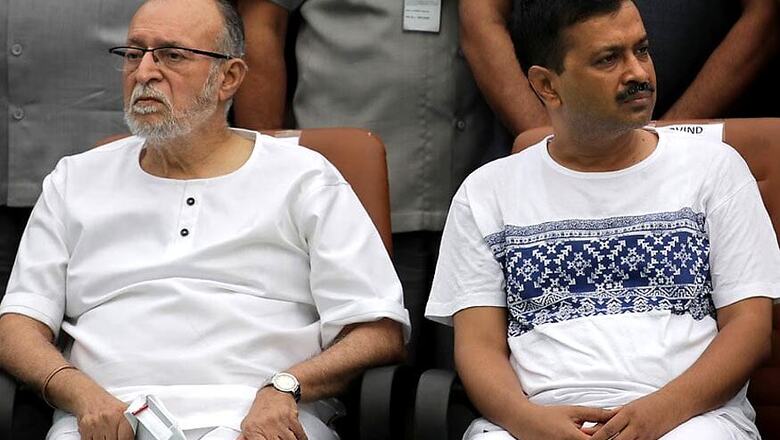Delhi Deadlock: How it Was Under Sheila Dikshit and What Changed After Arvind Kejriwal Came to Power

views
New Delhi: The Supreme Court on Thursday delivered a split verdict on the contentious issue of control of services in the national capital in the tussle between the Delhi government and the Centre, and referred the matter to a larger bench.
A two-judge bench comprising Justices AK Sikri and Ashok Bhushan, however, agreed on their views on disputes pertaining to the anti-corruption branch, setting up of commission of inquiry, control over electricity boards, land revenue matters and appointment of public prosecutors.
The apex court also upheld the Centre's notification that its employees cannot be probed in corruption cases by ACB of Delhi government. The top court also said that instead of the LG, the Delhi government will have the right to appoint public prosecutors or law officers.
Here’s a look at what the tug-of-war is about.
The Core Issue
In July 2018, a five-judge Constitution bench of the court had laid down broad parameters on the basis of which the capital would be governed. The court had said that Delhi can’t be accorded the status of a state, but added that the L-G doesn’t have any “independent decision-making power" and must act on the aid and advice of the elected government. What the court didn’t do is get into the individual challenges, pertaining to the distribution of powers in separate areas and left that to future adjudication.
Soon after, the L-G issued a statement, underlining that the L-G would continue to “control" services — effectively the power to transfer and control the postings of different bureaucrats — and cited a May 21, 2015 notification as evidence. Since then, the AAP has cried foul, maintaining that the government has “effectively been paralysed", while lambasting the BJP government at the Centre for “openly flouting the Supreme Court order". The L-G argued that the AAP government had “erroneously" interpreted the Supreme Court order and that the division of power would come only after the appeals pending before the court’s Regular Bench are disposed of.
Before AAP
The AAP government’s tenure in Delhi has been marked by uncharacteristic dissonance between the elected government and its bureaucrats. As per officers in the secretariat, it was the MHA’s 2015 order that effectively changed the power dynamics within the government, by taking away the transfers and postings from the elected government.
How did governments work before? Through an ‘unsaid understanding’, said a retired bureaucrat, who served closely with former CM Sheila Dikshit. The officer said, “There was an understanding with the L-G. Effectively, the L-G would decide the posting for senior officers like Principal Secretaries, but after taking the CM into confidence. For other officers, the CM would decide but always let the L-G know."
But within days of coming to power, this changed. The AAP alleged that officers in the Delhi government had been handpicked by the Centre — a charge that was vehemently denied. What has followed since, has been a series of altercations between the bureaucracy and the elected government, including the alleged assault on chief secretary Anshu Prakash and AAP’s claim that the bureaucracy was working to “paralyse" the government.
Why is the Judgment Crucial
As the tussle between the Centre and state continued, House Committees of the Assembly became the focus. It was alleged by bureaucrats and the BJP that these committees were being used to ‘target’ officers to further their political agenda, while AAP argues that it has been trying to inject accountability into an opaque government. “This just tells you how important controlling the services is for a government to function properly," said an AAP minister, adding that that taking the control of the bureaucracy away from them was akin to chaining the hands of the government.
The minister added, “We have attempted different things, but this is what it boils down to. If we ask them why a certain work hasn’t been completed, they will come up with some excuse. It all eventually boils down to the fact that we have neither carrot nor stick."
A senior serving bureaucrat countered, “I have worked with different governments in my tenure, but this government has no idea about how a government is supposed to function, instead it sees a conspiracy everywhere."
In May 2017, Delhi chief secretary, MM Kutty described the situation to the Delhi High Court as being akin to “caught between the devil and the deep sea".
The ACB
It is key to remember that the AAP is a party formed on an anti-corruption plank. This, more than anything else, was the rationale that drove the formation of the party. Within days of coming to power, the AAP looked to “strengthen Delhi’s Anti-Corruption Branch (ACB)" that had, so far, worked under the Delhi government. A new helpline was launched and a total of 32,489 calls were answered in the first 100 hours, a series of arrests of government officials followed.
The ACB is the state government’s vigilance department and gets its officers from the Delhi Police, while having the power to register FIRs in alleged corruption cases, and make arrests. After the July 2018 judgment, deputy CM Manish Sisodia had noted that the apex court had not given “any clarity" on the ACB issue. The Delhi government argues that since the ACB is the government’s vigilance department, it needs to be controlled by the Delhi government. The Centre, though, argues that since the ACB is a police station, with the power lodge FIRs, it needs to be under the L-G, since ‘law and order’ falls under its purview.

















Comments
0 comment